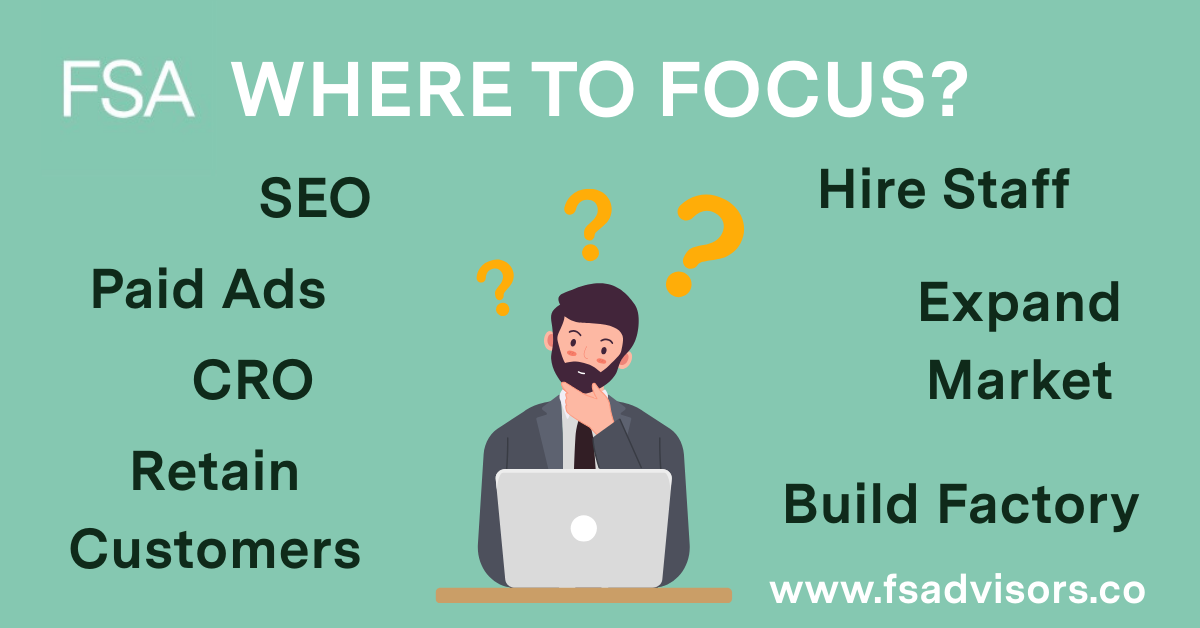 Use a bottom-up financial model + data—not instinct—to unlock the most profitable decisions in your business.
Use a bottom-up financial model + data—not instinct—to unlock the most profitable decisions in your business.
“If I could prove to you, mathematically, the exact three things to focus on to grow your business, would you be able to guess them correctly?” – Andrew Geller, CEO & Founder FSA
Most founders either don’t know—or can’t be confident—in their answers to this question. And that’s exactly the point.
The right decision isn’t always intuitive. In fact, it rarely is.
As entrepreneurs, when we make strategies, we’re inherently dealing with uncertainty about the future. By collecting relevant data and feeding it into a comprehensive bottom-up financial model, you can uncovering the variables that create the most impact on your bottom line revealing to your where your focus should be. You’ll understand the potential risks and rewards of different strategies, define the boundaries of uncertainty, and make decisions rooted in objective insight—not gut feeling.
A bottom-up model reveals which variables are really driving your growth. It makes it easy to build strategies to improve them. And as your company scales, even small improvements in those variables can translate into major gains in cash flow—and ultimately, wealth for you as the founder.
This is how you stop guessing and start scaling smart.
Why Intuition Isn’t Enough
We’re all wired to default to common strategies:
“Spend more on marketing.” “Hire faster.” “Open a new location.”
But urgent ≠ important.
That’s where decision-making systems come in. Sometimes, what you think is the lever to pull isn’t actually the most impactful one. A financial model shows you where your strategy is leaking—and how to fix it before you invest.
Example: Paid Ads vs. Conversion Rate Optimization (CRO)
Let’s say you run an ecommerce business and want to increase revenue on your website.
The intuitive move? Launch a paid social campaign.
But what if your website’s conversion rate is weak? You’d be pouring money into traffic that doesn’t convert.
The smarter move? Improve your conversion rate first—so every ad dollar goes further.
Using a real bottom-up financial model as an example and the data we have to analyze it, here’s what we can discern after inputting the expected costs and rewards of different strategies. This table shows the results of an analysis show over a 5-year forecast:
Strategy Comparison Using A Bottom-Up Financial Model (2025–2029)

✅ CRO alone beats Paid Social by over $4.7M in valuation. ✅ Combining CRO + Paid Social yields the highest valuation and profit overall.
And remember: all of this information is yours before you spend a dollar. The model lets you preview the impact, compare options, and choose the best outcome to focus on for your goals.
The Real World Cost of Churn: A Spotify Example
Let’s take a real-world example from Spotify.
Years ago, Spotify discovered they were losing nearly half of their free trial users within a month. The intuitive move might’ve been to spend more on ads to bring in new users.
Instead, they doubled down on spending on acquiring customers, they opted, less intuitively, to focus on reducing churn:
- Improving onboarding
- Personalizing playlists
- Sending re-engagement messages
The result? ➡ More predictable recurring revenue ➡ Higher customer lifetime value ➡ Stronger growth with less ad spend
By fixing the “leaky bucket,” Spotify boosted profitability—not by expanding marketing, but by making existing efforts more effective.
Bottom-Up Modeling: Where the Truth Lives
So how do you find the right lever to pull?
You need a bottom-up financial model built on real data from your business.
Model the drivers you actually control:
- Acquisition
- Conversion
- Retention / Churn
- Pricing
- Capacity
- Unit economics
Once you’ve modeled these, you should be able to easily answer these questions and create strategies around the answers.
- What happens if churn drops 10%?
- What’s the payback period on a price increase?
- Should you hire now or wait a quarter?
- Will this expansion cost increase or reduce your valuation?
The right answers are in your data. And the model brings it to life.
Final Thoughts: Stop Guessing. Start Modeling.
The best decisions aren’t always the obvious ones. But the math will show you the way.
If you’re debating whether to expand, hire, or hold cash… If you’re unsure where to focus next to unlock growth… If you want to know which strategy will put the most money in your pocket…
Let’s build the model and find out. Reach out at www.fsadvisors.co
